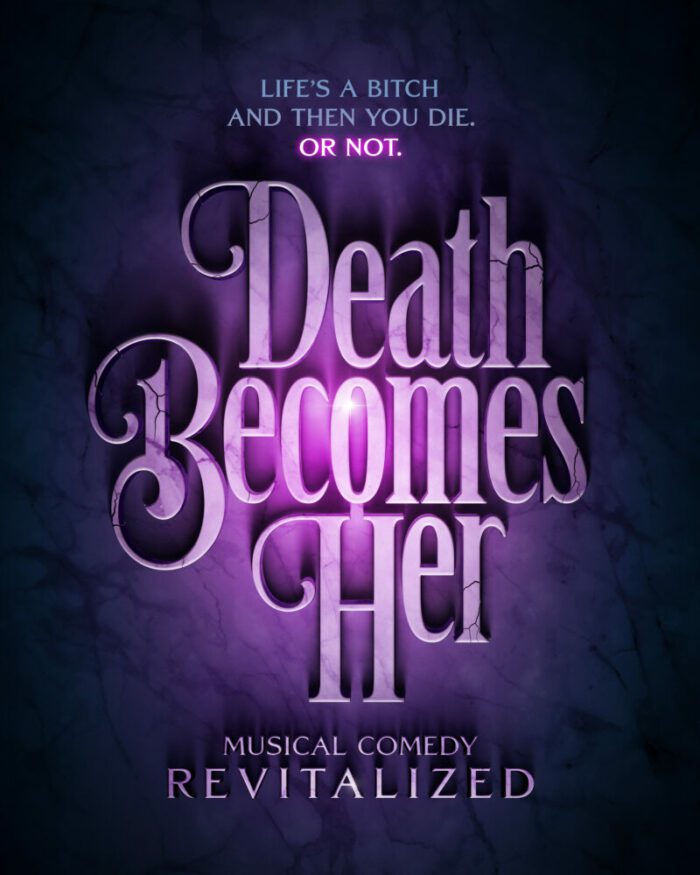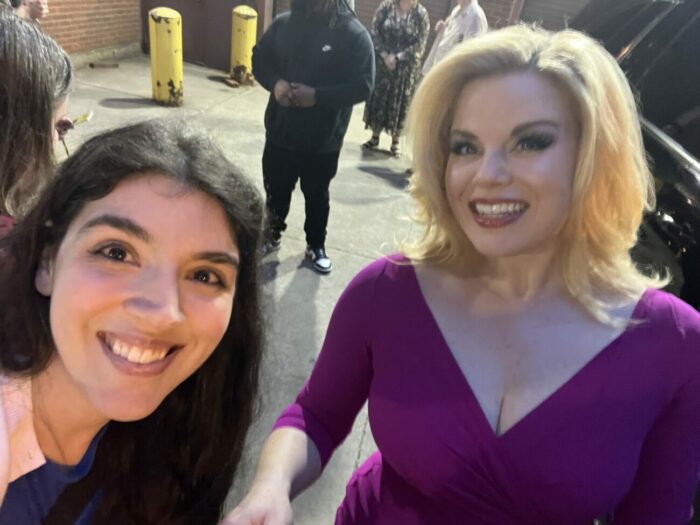Death Becomes Her is the latest in the trend of non-musical films singing and dancing their way from celluloid to the stage. Even with the recent uptick in such adaptations, it’s certainly not a new idea: it’s been done many times, and it’s been done to great success. When I discovered the film by complete accident, I was an instant fan. I felt like I’d discovered a rich, juicy secret. Don’t keep the lid on this musical: you’ll want to drink it to the very last drop.

Actor Madeline Ashton (Megan Hilty), semi-lovingly nicknamed “Mad,” and writer (and former actor) Helen Sharp (Jennifer Simard), semi-lovingly nicknamed “Hel,” are friends-in-competition stretching further back than the vain Madeline would want to admit. When Mal runs off with Hel’s fiancé, restorative plastic surgeon Dr. Ernest Menville (Christopher Sieber), Helen quickly spirals. Madeline slowly spirals as acting offers dry up and her life starts, to quote one of her songs, “Falling Apart.” Ernest spirals as he mourns going from, as Helen puts it, “saving poor, starving children,” to making rich people “look like poor, starving children.” Enter the mysterious Viola Van Horn (Michelle Williams), with a secret potion promising to solve all their problems…with a warning.

You definitely won’t be short of things to drink in. Death Becomes Her fully embraces everything about itself. It embraces its darkness, its comedy, being a musical, its cast, and its otherworldly concept.
It begins with a bang…both literally, with bangs of thunder and a bang of deliciously macabre and thrilling orchestration, and figuratively, with a shining figure rising from the floor and unveiling itself as Viola Van Horn. Her opening song, “If You Want Perfection,” melds with these elements to set up and cement the glamorous, macabre mystique of the show.
You’ll bust a hole in your gut laughing. From slapstick to puns aplenty, and from some of the film’s best bits to the cascade of new comedy, if something doesn’t land with you, the escalating series of jokes after it will. Just like her film counterpart, Mad “can see right through” Hel. Ernest sings about life married to Mad being “worse than Hel.” The only thing funnier than Madeline mocking Helen’s “mid-Atlantic accent” is Helen’s insistence on using it and making it ever stronger.
In case you’re wondering if Death Becomes Her embraces how its heightened concepts, comedy, and glamor make it oh-so-campy and fun, the second musical number has Madeline singing how everything she does is…“For the Gaze.” While dressed as Dorothy Gale at the center of a kick line of dancers dressed in sparkling rainbow colors.
Oh, it knows what it’s doing.
Between more emotional moments and some subtle jokes, bombastic moments like this are about as subtle as a smack in the head with a shovel. And that’s a wonderful thing.

But it’s not an invitation! Watch where you’re swinging those things!
The characters in Death Becomes Her are rich (figuratively…but also literally wealthy). The musical makes several story additions and alterations that really work well. With the show’s longer runtime (2 hours and 30 minutes compared to the film’s hour and 44 minutes), we get to see even more of the characters. If you’re a fan of the film, you’ll still be consistently surprised at all the twists and turns. Yes, even that “twist,” which the show knows is one of the moments knowing audiences are waiting for, is given extra flourish and its proper spotlight. (Madeline wouldn’t have it any other way.)
Helen is a lot more involved and even more present than in the film. Her presence is a welcome one, adding extra elements to scenes and adding depth to her relationships with Ernest and Madeline. As a fan of the film, there was a key moment in the musical that still surprised me not because I didn’t know it was coming, but because Helen was the one taking matters into her own hands. Viola Van Horn (renamed from the film’s “Lisle von Rhuman”) gets a huge expansion. Her name change turns into a great visual, with her glowing pink “V” initial resembling her glowing pink vial of potion. These story changes and this extra time with the characters also make Ernest much more compelling and a more appealing character when his turn in the spotlight later in the show rises to the rooftops. Christopher Sieber’s funny, vulnerable, and at times, appropriately enough, “earnest” performance gives even more emotional heft to the show.
Madeline and Helen forcefully interrupt Ernest’s singing at one point and Madeline comments on how at least it stopped the music, which is a lovely gag. Which brings us to…
In a very fitting move for the story, the memorable music (Noel Carey and Julia Mattison, I still have some of your tunes in my head as I write this!) and “Sharp-ly”-written book (Marco Pennette) allow all four principals—Madeline Ashton, Helen Sharp, Dr. Ernest Menville, and Viola Van Horn—to shine. The world may tell Madeline and Helen that they’re too old to be relevant, but Death Becomes Her shows the stories, perspectives, and talent the world misses out on when it dismisses people based on age. Megan Hilty and Jennifer Simard get to showcase all the vocal acrobatics they can do. Megan Hilty belts to the back row and hits classical high notes in the same song…and also screams at a young valet that she wants his skin. Jennifer Simard has to change her voice from the measured mid-Atlantic, to some leftover quirks from her stay at the “mental institu—spa,” to growling and demonic vocals all in the same line…or a string of “la la las.” Not to mention a monologue delivered at an increasingly “breakneck” speed, only stopping to breathe at the very end.
As soon as the cast album and sheet music are released, I will be first in line.
I want to give a hefty shout-out to the ensemble. Being in the ensemble can be a thankless role, but in Death Becomes Her, they are constantly onstage: dancing, literally moving the show along, being stunt and dance doubles, and playing roles like a recruiter for Viola and Mad’s “number one assistant.” While Mad’s assistant is only in Act 1 and I wish we could’ve had him in Act 2, the actor still gets a lot of stage time in Act 2, including a “rockstar” cameo. When they’re in their costumes as Viola Van Horn’s clients, they add an extra element to the show reminding us of Viola’s constant presence, watching over everyone and everything.

Viola has an ensemble you could die for…and I’m not just talking about her outfits.
Viola’s expanded to being present throughout the musical. Michelle Williams exudes an ethereal mystery. Thanks to the varied visual effects, you never know when or where she’ll make her next grand entrance. I distinctly remember a specific moment when I thought she was still onstage…only for her to re-enter from the other side of the stage. This adds to the “glamorous macabre” mood of the show and adds so much to the character of Viola. She’s always there, somewhere. She’s always watching. She’s always waiting to make her next jaw-dropping entrance.
If you’re familiar with the film, you’re probably curious how, or even if, some of the film’s technologically groundbreaking visuals translated to the stage. Not only does Death Becomes Her adapt the most memorable visuals from the film and put them onstage right in front of you, but it also adds to those visuals and spreads its own all over the musical. The glowing vial still balances impossibly on the table. Madeline still has her problems with stairs, which impressively stretch from the floor to the top of the stage. Did Madeline’s song that opens the film make its way into the musical? Oh, yes. But you’ll never guess how.
I recognized so many of the visual effects as classic magician effects. Some did use technology. Some are so simple in retrospect, but the fact that they’re hidden so well until they happen still left the audience awestruck. From the aforementioned body switches, costume changes and reveals, and hidden entrances, to doing an extra flourish and proving even further that yes, they can do that effect live on stage, it’s a wonder to behold.
Paul Tazewell’s costumes not only are striking and unforgettable but also often serve a double or even triple purpose. Mad’s leopard outfit gives a fun reveal and a great visual gag. So many costume changes happen lightning fast, many onstage, and some in full view of the audience.
“For the Gaze” alone has so many costume changes to gaze at, with the reveals done in so many different ways, your head will spin (which is good practice for what happens later in the show). These changes and reveals, just like several others in the show, no doubt had to be precisely planned, constructed, and timed. On opening night, every one was done flawlessly: not a stitch or hair out of place. Kudos to the cast and to Paul Tazewell.
The Producers (1967), The Little Shop of Horrors (1960), and Hairspray (1988) are all non-musical movies that became stage musicals…and then became musical movies, but that’s a different conversation. (I’ve even written about the musical movie of Little Shop of Horrors (1986)!)
As a creative person, I’m never one to say, “That’ll never work!” The fact is if you think about some of the art that’s left the biggest impression on us—whether individually, in certain circles, or on a larger scale—in almost every single case, there’s a part of the art that, without knowing the piece’s success, would sound crazy. On top of that, that specific part is usually crucial to making it what it is and to its success. Make anything you want into a musical. Why not? It’s not going to kill anyone.
…Okay, maybe the wrong choice of words for this specific case.

Death Becomes Her is serving its magic potion at Chicago’s Cadillac Palace Theatre through June 2. The show opens on Broadway this fall. I’m warning you: don’t miss it.
Don’t say I didn’t…




